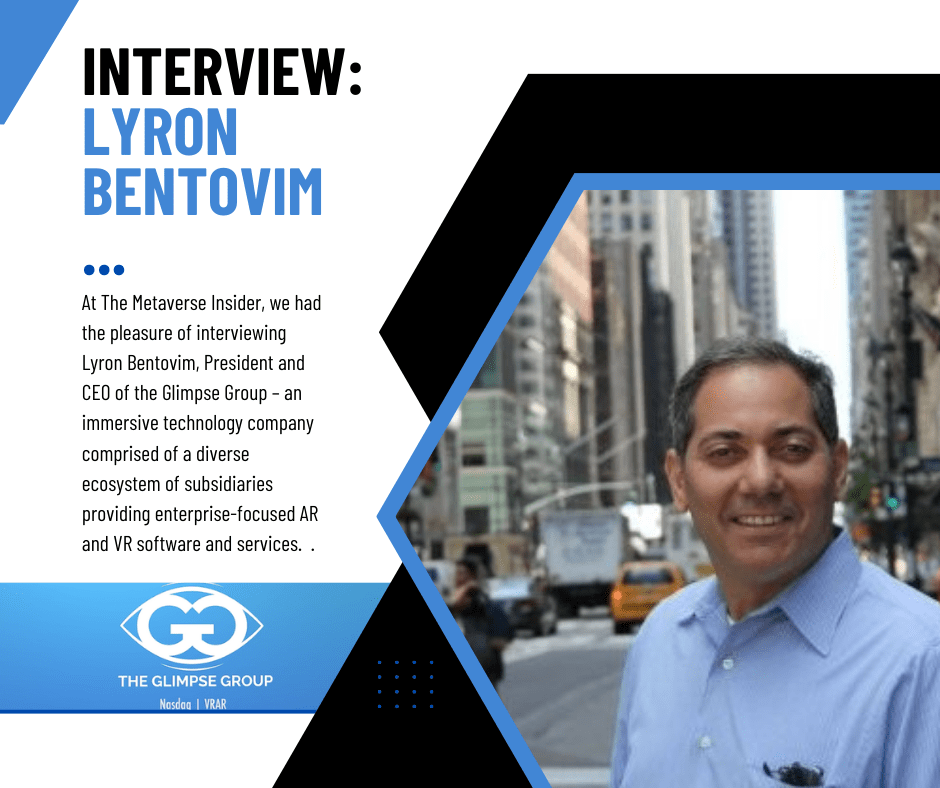At The Metaverse Insider, we had the pleasure of interviewing Lyron Bentovim, President and CEO of the Glimpse Group – an immersive technology company comprised of a diverse ecosystem of subsidiaries providing enterprise-focused AR and VR software and services.
The Glimpse Group works across many different industries including healthcare, education, entertainment, and retail – offering software and services to enable businesses to implement AR/VR solutions. In this article, we cover part 1 of our conversation with Lyron – exploring his perspectives on immersive technology and how this will affect the future of the Metaverse.
The Glimpse Group origins – the start of a new tech cycle
In late 2015 and early 2016, Lyron realized that we were at the beginning of a new tech cycle – taking us from the digital world to an immersive world. In occurring every 35 years or so, this cycle would be driven by three main technologies, namely immersive technologies (virtual and augmented reality), artificial intelligence, and blockchain. Lyron saw an opportunity to build a company that could efficiently manage startups in this space; the challenge with startups was that there was not a big market in the early stages, thus, it was difficult for them to scale without access to larger budgets:
“I wanted to build something that we will be able to scale and [where we can] really thrive when we get to the later stages of the cycle.”
Ambiguity in defining the Metaverse
Many of us in the industry are aware of the inconsistency in defining the Metaverse; people are either not aware of what it entails or have tried to pre-emptively define it before it has been properly established.
Defining the Metaverse is a complex and evolving topic that requires input from industry experts from the three driving technologies. It is a concept that does not currently exist but is being explored and tested by various groups. Early definitions of the metaverse may not accurately capture what it will become as it continues to develop, much like how early definitions of the internet and cloud computing evolved over time:
“If you went back into the early 90s, where [the internet] was just beginning to happen, people would have defined things differently in terms of what you would do with it, how would it work, and what would happen in it.”
“I think that there’s a lot [of discussion] to be had, in terms of where we’re going. But it’s going to be a very interesting and exciting phenomenon.”
What are the four buckets of use cases for immersive technology?
Lyron states that there are many use cases for immersive technologies across various industries, which can be categorized into four main “buckets”:
- Marketing
- Learning
- Visualization
- Social Interaction
The first use case is marketing. With immersive technologies such as augmented reality and virtual reality, brands are able to showcase their products and interact with consumers in a more engaging way. This is particularly powerful with Gen Z consumers who are drawn to these types of experiences. Companies that have complex products or solutions can also use immersive technologies to market their offerings more effectively. For example, a company that designs and builds airplanes can use virtual reality to allow customers to explore the inside of the plane without needing to physically see it.
The second use case is learning. Immersive technologies can be used in K-12 schools, universities, and colleges, as well as for professional and corporate training and medical professional training. The ability to learn through immersive technologies can be much more effective than traditional methods, as learners are able to experience and practice real-world scenarios in a safe and controlled environment. For example, healthcare workers can learn how to clean a hospital room between patients in virtual reality, which allows them to practice and master the technique in a more efficient way than in-person training.
The third use case is visualization. Immersive technologies can allow users to see things that do not exist yet, such as buildings that are in the design phase or products that are being developed. This is particularly useful for architects, designers, and engineers who can use immersive technologies to visualize their designs in a more realistic and detailed way than traditional 2D renderings.
The fourth use case is social interaction, which is the end game for immersive technologies and the Metaverse. Users will be able to interact with others in immersive worlds and do things together that they might not be able to do in the physical world. This includes things like attending a concert or gaming with friends, as well as educational or training experiences. As the Metaverse continues to develop, this use case will become more important and prevalent.
What is the future of XR?
“I think the Metaverse is the next iteration of the internet, which is moving from a 2D environment to a 3D environment.”
Lyron discusses the evolution of screens, from the 2D screens of TVs to the screens of various sizes found in computers, laptops, iPads, iPhones, and other devices. He says that while immersive worlds can be accessed on a computer, true immersion can only be achieved through headsets, which can provide a fully immersive experience:
“When you go in VR, and you’re fully immersed in [the experience], then that changes the story.”
A common belief that is shared with Lyron is that the size of headsets will decrease over time – eventually resembling glasses and that in the future, people will be able to control what they see, whether it’s the real world, an augmented world, or a virtual world.
Lyron also predicts that contact lenses will be developed in the next 15-20 years and will enable people to flick between the real, augmented, and virtual worlds. Furthermore, Lyron also believes that in the next 30-40 years, it will be possible to communicate taste directly to the brain, allowing people to taste virtual food and drinks in a fully immersive way:
“So, when we drink a virtual glass of wine in the metaverse, we will actually taste that wine and not only taste wine, but we will [also] taste the difference between a Bordeaux and a kind of Pinot Noir from California, and Canada.”
This may seem like a distant future, but so did the concept of a Metaverse not so long ago. It is clear that Lyron and his team at The Glimpse Group are at the heart of innovation when concerning immersive technologies and their potential applications. In enabling rapid growth and the efficient scaling of many companies under The Glimpse Group’s umbrella, it is evident that they are drivers for Metaverse adoption. As XR is the future of experiencing the Metaverse, we can expect to hear much more about The Glimpse Group in the near future.

















